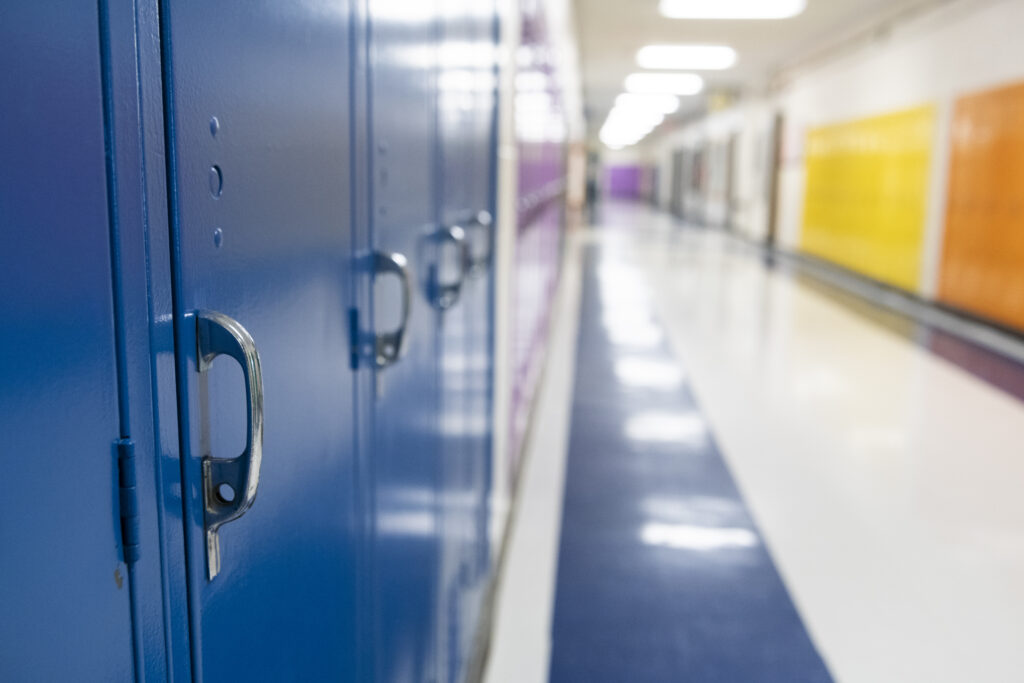In the first couple weeks of September, the West Virginia Department of Homeland Security said it received reports of 138 threats to 69 schools in 33 counties in the state. (Lexi Browning | West Virginia Watch)
From pop songs, to family milestones, to political sloganeering in election years and policy making by those in office, variation on the theme “for the children” is used as a clarion call for better things for the next generation. Less melodious and trendy is what to do when children become the threat.
News stories about violence and schools, ranging from hoax threats and the usual disciplinary issues to the worst case scenarios of active shooters, are relentless. The latest numbers from the West Virginia Department of Homeland Security detail that over the early days of September, 138 threats were received by 69 schools in 33 counties. Those numbers would constitute threats in one week to 20% of the schools in West Virginia. Over half the counties in the state with fresh threats to sort through, with more assuredly to come.
Threats, as it turned out, largely came from a viral TikTok “hit list” that quickly spread across social media. While some students in West Virginia were also being detained and questioned, much of the recent rash of threats came from out of state.
The FBI’s Clarksburg office felt compelled to issue a statement about the rash of threats not only in West Virginia but also adjacent Pennsylvania, on Sept. 11 of all days, with the usual wording about “coordinating” and “assisting” in identifying and mitigating threats. Gov. Jim Justice responded by directing homeland security to establish a task force of involved agencies and create a “centralized hub” to be activated and coordinate incident response.
This is the hard part of bridging headlines and worry to policy and action. Most of the recent threats to West Virginia schools were hoaxes or students making empty threats to further a vicious viral trend. But all it takes is one of those threats to be real, and have access to a weapon, and show up to a school, and to slip through the parental, social, school, and law enforcement cracks to create a tragedy.
With the latest threats to West Virginia causing justified response, a look at the recent murder of two students, two teachers, and wounding of nine others at Apalachee High School in Georgia should be a teachable moment. The charged gunman was a student with known issues, having been investigated by the FBI and local authorities previously as a potential threat. Colin Gray, the gunman’s father, was swiftly charged as well. While the Grays will get their day in court, what is clear is once again a mass shooting was perpetrated by a known threat that wasn’t dealt with despite being identified.
Holding parents legally liable for the actions of their children has always been a controversial matter both legally and in society. It is also becoming depressingly necessary. The Secret Service detailed in their 2019 analysis of targeted school violence that all the attackers they profiled exhibited concerning behavior, and most elicited both concern from others and the attackers’ communicated intent. Also, the report states, “Nearly every attacker experienced negative home life factors” and that all the attackers experienced social stressors before acting. Combined, the picture of the people who should be most involved with a potential attacker are the ones most likely to identify and prevent violence. But at Apalachee, the parent is charged as being the enabler of the violence.
When gun violence in schools makes headlines, a predictable cycle of response begins. The debate quickly goes directly to the politically and culturally charged issue of guns. Administrators will point out how things like physical security upgrades require funding investment. There is the push/pull between local officials, parents and teachers over how much law enforcement presence at schools is needed, wanted, necessary and healthy.
All worthy topics of great importance. All reactionary responses after there is blood spilled and violence perpetrated by a student upon a school.
How to prevent modern attacks, especially in the face of rising and technologically enhanced threats, requires hard questions on very old topics. Questions of when should law enforcement be held accountable for not following up on known threats. The politically charged, ethically difficult and legally fraught matter of where do parent’s rights and the state’s obligation for public safety meet and when does one override the other? The very uncomfortable conversations of parents, peers, adults and students who see things — not only someone’s behavior and actions but also on social media and their online persona — and knowing when to get authorities involved.
That last one is not helped by state agencies like the West Virginia State Police and Department of Human Services having separate scandals, bad press and notable communication issues between themselves and the public. Or by a state that is far behind on services like adolescent mental health care options. “See something, report something” carries more weight when the citizens have faith their “do something” will result in something being done.
Like multiple choice test questions on school tests, the answers of protection, security and mitigating threats “for the children” requires an all of the above answer and approach in vigilance, accountability and effort. Recent evidence shows it doesn’t take just one child to perpetrate violence upon a school and community. It takes a child that has been failed by various adults on multiple levels to turn a student into a shooter. Accountability and corrective action should be something adults should get busy doing, for the children.
GET THE MORNING HEADLINES DELIVERED TO YOUR INBOX

